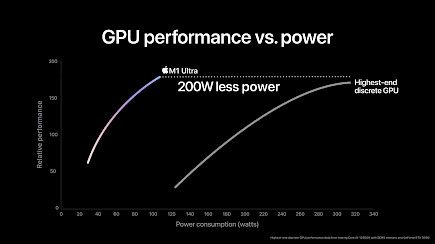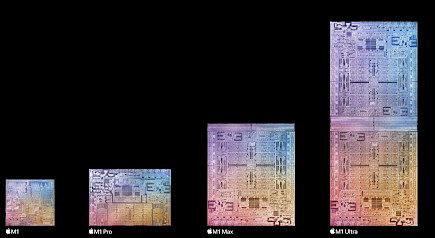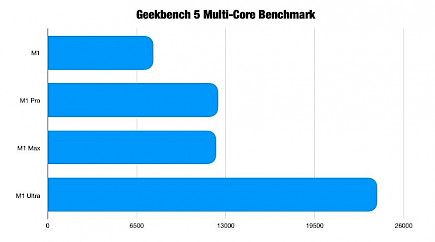
This year’s first-quarterly Apple event saw an array of impressive products being released.
But, none of them came as a bigger shocker to the global audience than the M1 Ultra Soc Chipset.
And, here’s why…
What Exactly Is the new M1 Ultra SoC?
The Apple M1 Ultra is Apple's newest (and final) silicon system-on-a-chip (SoC) within the M1 family. It was announced during the Peak Performance event along with other innovations.
Because it's an SoC, it means that all components of the computer reside on one chip instead of an individual GPU, CPU, and so on. The processor actually comes from two M1 Max chips, which were part of the year before's release.

The two chips are linked by UltraFusion, which is Apple's technology used to connect processors. UltraFusion utilizes an interposer made of silicon to connect the chips instead of the traditional connection made through the motherboard. As a result, the M1 Ultra's chips are connected to thousands of signals, which is 2.5 TB/s in low-latency inter-processor bandwidth.
The M1 Ultra has an extraordinarily powerful 20-core CPU that has a high-performance 16 cores and four cores with high efficiency. In addition, the chip's memory bandwidth is 800 GB/s. At the same time, the M1 Ultra is able to be set up to include 128 GB of uni-directional memory.

The 32-core Neural Engine within M1 Ultra runs up to 22 trillion operations per second. This is dedicated to machine-learning tasks. In the past, Apple used this for audio and video processing onboard and other everyday processes.

With twice the capabilities of the media engine as the M1 Max, the M1 Ultra is also an astonishing ProRes video decoder and encoder. In addition, the M1 Ultra supports playback of up to 18 streams of 8K video, which is an incredible number to record.
M1 Ultra: Power of the Processor
The first thing you'll notice is that the M1 Ultra is very powerful. The figures Apple presented at the "Peak Performance" event were genuinely impressive. Apple's M1 Ultra is made of two M1 Max processors, so it's supposed to be twice as efficient, isn't it?

The M1 Ultra beats out the most popular specification of the Mac Pro. But, to clarify, it's Apple's most expensive model, with certain configurations reaching up to $50,000.
Based on Apple's graphs from during the presentation, the M1 Ultra is 50 percent faster than the Mac Pro while completing the tasks. In addition, it consumes 90% less power than a desktop system (with the Intel Core i9) but is nonetheless quicker.

These graphics run 3.4x more efficiently than the Mac Pro and use 200W less power than the most powerful GPU (GeForce GTX 3090), yet are still more efficient.
We all know that Apple uses unclear graphs and comparisons to older models to showcase the capabilities of new processors.
The base M1 Ultra comes with twice as much... twice more of everything compared to the standard M1 or Max.

This M1 Ultra has a 20-core CPU rather than a 10-core, a GPU with 48 cores rather than 24, a 32-core neural engine rather than 64GB, and a 16-core unified memory rather than 32GB. It's possible to go on, but you'll see the idea.
There's a leak of a test from Geekbench for the brand new M1 Ultra, which is the first test of real-world performance. The benchmark gives a one-score performance of 1,793, and the multi-core score is 24,055. This is a huge improvement over the Mac Pro, with 40% higher single-core performance and 15% more multi-core performance.

The M1 Ultra is first coming to the brand new Mac Studio. We'll need to wait until March 18th to see additional benchmarks for the M1 Ultra. After that, we're likely to be disappointed.
Who M1 Ultra is for?
We've seen the incredible power of the M1 Ultra, and all of the numbers could have been a bit frightening to take in. But, it's the M1 Ultra that's powerful; there's no doubt about it.
The M1 Ultra is designed for professional use and not for daily use by the average consumer. So naturally, anybody can set up a Mac Studio with an M1 Ultra, but it's not recommended.
With the amount of power available in the M1 Ultra, the average user isn't likely to utilize all of it. So most likely, you're not going to require the M1 Ultra's performance unless you're operating in a professional studio.
NOTE: If we go by Apple's graphs, it's so powerful that even some professionals may not be able to benefit entirely from the performance that the M1 Ultra offers!
M1 Ultra has been created to cater to the top tier of professionals. People who perform the most difficult of jobs require the most computing power they have at their disposal. So it's a crucial market to conquer (or, more accurately, be dominant), which is why it's an excellent announcement by Apple.





